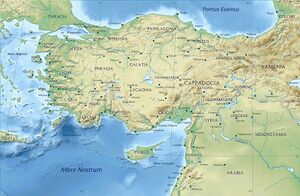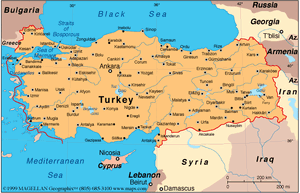Zile
| Author:Laxman Burdak, IFS (R) |


Zile, anciently known as Zela is a city and a district of Tokat Province, Turkey.
Variants
- Zela (Greek: Ζῆλα) (Pliny.vi.3)
- Ziela (Pliny.vi.4)
- Zelitis (Greek: Ζηλίτις)
- Zelid
- Anzila
- Gırgırıye (Karkariye)
- Zīleh
- Zilleli
- Zeyli
- Silas (Greek: Σίλας)
Jat clans
- Jeela = Zela (Greek: Ζῆλα) (Pliny.vi.3)
- Gil = Zile = Zela (Greek: Ζῆλα) (Pliny.vi.3)
- Anjal = Anzila = Zela (Greek: Ζῆλα) (Pliny.vi.3)
- Karkar = Gırgırıye (Karkariye) = Zela (Greek: Ζῆλα) (Pliny.vi.3)
Jat Gotras Namesake
- Jeela = Zela (Greek: Ζῆλα) (Pliny.vi.3)
- Gil = Zile = Zela (Greek: Ζῆλα) (Pliny.vi.3)
- Anjal = Anzila = Zela (Greek: Ζῆλα) (Pliny.vi.3)
- Silas (Greek: Σίλας) = Zela (Greek: Ζῆλα) (Pliny.vi.3) (Silas is a village in Degana tehsil of Nagaur district in Rajasthan)
- Karkar = Gırgırıye (Karkariye) = Zela (Greek: Ζῆλα) (Pliny.vi.3)
Location
Zile lies to the south of Amasya and the west of Tokat in north-central Turkey.
Name
Historically, Zile has been known as Zela (Greek: Ζῆλα), Zelitis (Greek: Ζηλίτις), Zelid, Anzila, Gırgırıye (Karkariye), Zīleh, Zilleli, Zeyli, and Silas (Greek: Σίλας).
History
The city has a long history, including as former bishopric and the site of the Battle of Zela, which prompted the phrase "Veni, vidi, vici."[1] Today the city is a center for agricultural marketing and tourism.
Zile castle, the only solid castle in Anatolia, was built by Roman commander Lucius Cornelius Sulla. The castle contains the Amanos temple, and is called silla, meaning "respected". In Semra Meral's Her Yönüyle Zile, she claims that the name "Zile" came from "Zela", stemming from "Silla".[2]
Ancient City: According to recent archaeological research, there is evidence of human habitation since Neolithic times in Zile.[3] In his book Geographica, Strabo claimed that Zela was founded by Semiramis, a legendary Assyrian queen.[4] By 548 BC, Zela and greater Anatolia were under the rule of Achaemenid Persian Empire. Persian rule saw construction of a portion of the Royal Road in the area, and of temples to the Persian gods Anahita, Vohu-Mano, and Anadates in the city itself.[5] Darius I of Persia divided the largest Anatolian state of that time, Cappadocia, into two, with Zela remaining in Pontus Cappadocia, the northern region.
Classical Era: After roughly 200 years of Persian rule, Alexander the Great captured Zela from Darius III of Persia as a result of the Battle of the Granicus (334 BC). Following Alexander's death in 323 BC and the collapse of his empire, Zela passed to the Seleucid Empire, a Hellenistic successor state of Alexander the Great's dominion. It controlled the area for 200 years, but by 100 BC, its power in the region started to collapse. As a consequence, King Mithridates VI of Pontus attacked and took Zela in 88 BC, and ordered the killing of all Romans living there. This led the nearby Cappadocians to call on Rome for help. The Roman army, under Sulla's command, fought and defeated Mithradates in the First Mithridatic War. Mithridates attacked Zela again in 67 BC with the help of his Armenian ally Tigranes the Great, king of Greater Armenia, initiating the Third Mithridatic War,[6] which ended with victory by the Romans under Pompeius Magnus and the suicide of Mithridates in 63 BC. In Pompey's settlement of Pontus, Zela received a civic constitution and a sizable territory thus transforming from its previous status as a temple domain to a city.[7]
In 49 BC, civil war broke out between Julius Caesar and Pompey. While the Romans were distracted by this, Pharnaces II of Pontus, son of Mithridates, decided to seize the opportunity and take revenge for his father. His attack on Zela was halted by Julius Caesar in the bloody Battle of Zela (47 BC).[8] While Caesar's army suffered great losses, Pharnaces's was completely destroyed in five hours. After this victory, Caesar sent his famous message to the Roman Senate: "Veni Vidi Vici", meaning "I came, I saw, I conquered".[9] Caesar's words were written on a cylindrical marble column and placed in the city castle.[10]
According to Strabo, Zela had the temple of Anaïtis (Greek: ἱερὸν τῆς Ἀναΐτιδος), who was also revered by the Armenians.[11]
Attractions
There are several columns in the center of the castle, but some researchers claim that the actual column with Caesar's famous words was stolen, and the thieves have not been found yet.[12] There are many other historical buildings and artifacts from Hittites, Lycians, Persians, Greeks, Romans and Turks in Zile. Among these, Zile castle, the Roman theatre, Ulu Camii and Çifte Hamam are the most famous. Kaya Mezarı, Kusyuva, Çay Pınarı, Imam Melikiddin Tomb, Seyh Musa Fakih Tomb, Elbaşı Mosque, Mast Tumulus, Namlı Hisar Kale, Anzavur Caves, Hacı Boz Bridge, Koç Taşı and Manastry in Kuruçay are also popular.
The remains of the Roman theatre are visible to the east of the citadel hill, together with some rock tombs. Two Ottoman baths, the Yeni Hamam and the Çifte Hamam, date from the 16th and 17th century and the Hasan Aga Madrasah was built in 1497. The Boyaci Hasan Aga Mosque with its stalactiform prayer niche dates from 1479 and the Seyh Musa Fakih Tomb is also very old with 1106 or 1305 given as possible construction dates.
Mast Tumulus, an ancient site located in Zile, is of special importance since it hosts the palace of a Hittitite ruler, earthenware utensils and Hittite hieroglyphics.[13]
Mention by Pliny
Pliny[14] mentions....In its (Cappadocia) remaining districts there is Melita,8 founded by Semiramis, and not far from the Euphrates, Diocæsarea,9 Tyana,10 Castabala,11 Magnopolis,12 Zela,13 and at the foot of Mount Argæus14 Mazaca, now called Cæsarea.15
8 Which gave name to the district of Melitene, mentioned in c. 20 of the last Book.
9 Near Nazianzus, in Cappadocia, the birth-place of Gregory Nazianzen. The traveller Ainsworth, on his road from Ak Serai to Kara Hissar, came to a place called Kaisar Koi, and he has remarked that by its name and position it might be identified with Diocæsarea. Some geographers, indeed, look upon Diocæsarea and Nazianzus as the same place.
10 Its ruins are still to be seen at Kiz Hisar. It stood in the south of Cappadocia, at the northern foot of Mount Taurus. Tyana was the native place of Apollonius, the supposed worker of miracles, whom the enemies of Christianity have not scrupled to place on a par with Jesus Christ.
11 Some ruins, nineteen geographical miles from Ayas, are supposed to denote the site of ancient Castabala or Castabulum.
12 This place was first called Eupatoria, but not the same which Mithridates united with a part of Amisus. D'Anville supposes that the modern town of Tchenikeb occupies its site.
13 Or Ziela, now known as Zillah, not far south of Amasia. It was here that Julius Cæsar conquered Pharnaces, on the occasion on which he wrote his dispatch to Rome, "Veni, vidi, vici."
14 Still known by the name of Ardgeh-Dagh.
15 Its site is still called Kaisiriyeh. It was a city of the district Cilicia, in Cappadocia, at the base of the mountain Argæus. It was first called Mazaca, and after that, Eusebeia. There are considerable remains of the ancient city.
Mention by Pliny
Pliny[15] mentions....The river Iris brings down to the sea the waters of the Lycus. In the interior is the city of Ziela1, famous for the defeat of Triarius2 and the victory of C. Cæsar.3
1 The same place apparently as is mentioned in the last Chapter under the name of Zela.
2 Valerius Triarius, one of the legates of Lucullus, in the war against Mithridates. Plutarch tells us that Lucullus was obliged to conceal Triarius from the fury of his troops.
3 Over Pharnaces, the son of Mithridates.
References
- ↑ https://en.wikisource.org/wiki/Catholic_Encyclopedia_(1913)/Zela
- ↑ Meral, Semra (1990). Her yönüyle Zile. Zile: Sanem Press. OCLC: 23573866.
- ↑ Özgüç, Tahsin (1978). Excavations at Maşat Höyük and investigations in its vicinity. Ankara: Türk Tarih Kurumu Basımevi. OCLC: 5752663.
- ↑ Texier, Charles (1862). Asie mineure. Paris: Didot Freres. OCLC: 6646889.
- ↑ https://en.wikisource.org/wiki/Catholic_Encyclopedia_(1913)/Zela
- ↑ Smith, William (1851). A New Classical Dictionary of Greek and Roman Biography, Mythology and Geography. New York: New York, Harper & Brothers. OCLC: 2775910.
- ↑ Richard Stillwell; William L. MacDonald; Marian Holland McAllister. "The Princeton Encyclopedia of Classical Sites". The Princeton Encyclopedia
- ↑ "Zile". Encyclopædia Britannica. 2007.
- ↑ https://en.wikisource.org/wiki/Catholic_Encyclopedia_(1913)/Zela
- ↑ NTVMSNBC (2004). "Zile'de 'Geldim - Gördüm - Yendim'". NTV Turkey.
- ↑ STRABO, GEOGRAPHY, Book XII, Chapter 3, 37
- ↑ NTVMSNBC (2004). "Zile'de 'Geldim - Gördüm - Yendim'". NTV Turkey.
- ↑ Gaziosmanpasha University. "TOKAT". Gaziosmanpasha University.
- ↑ Natural History by Pliny Book VI/Chapter 3
- ↑ Natural History by Pliny Book VI/Chapter 4
Back to Jat Places in Turkey

